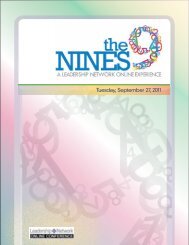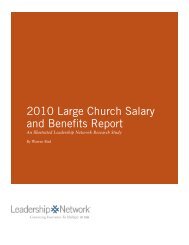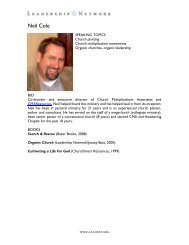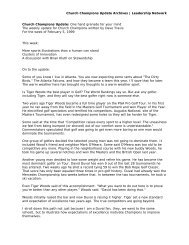ARE WE A PEOPLE AT HALF TIME? - Leadership Network
ARE WE A PEOPLE AT HALF TIME? - Leadership Network
ARE WE A PEOPLE AT HALF TIME? - Leadership Network
Create successful ePaper yourself
Turn your PDF publications into a flip-book with our unique Google optimized e-Paper software.
“ The key to impacting the<br />
culture is to enlarge the vision<br />
o f your role as Christ’s follower<br />
in the world.”<br />
“We’re learning that the<br />
capacity to form authentic<br />
relationships is the key to<br />
––Joel Ve s t a l<br />
S e rvLife International<br />
“God clothed his message in Jesus<br />
Christ, not in a neon sign.”<br />
––Art Ayris<br />
F BC, Leesburg, FL<br />
crossing traditional boundaries.”<br />
––Jim Herr i n g t o n<br />
Mission Houston<br />
crossing traditional boundaries<br />
Crossing traditional boundaries.<br />
Not long ago,60 pastors gathered in a park in<br />
O m a h a ,N eb ra s ka They . represented a spectrum of<br />
d e n o m i n a t i o n s ,s o -economic c i and ethnic groups<br />
that exist within the city. They didn’t gather to deb a t e<br />
doctrine or accuse one another of “sheep stealing.”<br />
I n s t e a d,they gathered to shoot a commercial. “T h e<br />
Church of Omaha welcomes you,” the commercial<br />
declared—a strong message coming from a city of<br />
“one church,many congrega t i o n ” s .<br />
“The level of unity we’re seeing now would hav e<br />
been unthinkable even five years ago,” says Eric<br />
Be n t s ,coordinator for Embrace Omaha, a cityreaching<br />
orga n i zation woven together by dozens<br />
o f churches in the region. Trinity Church, w h e r e<br />
Eric is on staff, was one of the key churches in<br />
establishing a strong prayer network throughout<br />
the city. “We have been prayer-walking downtown<br />
for 10 years and we have a network of i n t e r c e s s o r s<br />
that currently includes over 200 people representing<br />
all the churches.”<br />
God has answered their prayers in astounding<br />
w a y s .“Our childrens, youth and singles ministries<br />
are all interconnected with other churches,” says<br />
E r i c. In addition, a new unity has developed among<br />
the Christian business leaders. God is “e m p o w e r i n g<br />
Christian businessmen to take the gospel into<br />
the work p l a c e ”,<br />
says Eric. All this stems from the<br />
unity among the church leaders within the city.<br />
“ I t’s all built on relationships between leaders,<br />
oiled by the leadership of the Holy Spirit.”<br />
According to Eric and other city-reachers across the<br />
c o u n t ry, building strong, v u l n e rable rel a t i o n s h i p s<br />
among church leaders is t h ekey to reaching a city.<br />
Gauging success by transformed lives.<br />
E f fective missional churches are finding creative<br />
ways to embrace the culture,cross traditional<br />
boundaries and plant new churches.But how<br />
do these churches effe c t i v ely gauge the impact<br />
o ftheir ministry This is an area yet to be fully<br />
explored as churches begin to come to grips with<br />
the question,“What difference are we making”<br />
Missional churches are beginning to ask the<br />
question and search for indicators that tell them<br />
t h e y’re making a lasting impact for the Kingdom.<br />
One indicator is finances.“We look at how people are<br />
giving financially,” says Art Ay r i s associate , pastor at First<br />
Jim Herrington, executive director of M i s s i o n<br />
H o u s t o n ,has seen firsthand what dramatic things<br />
can happen when church leaders get together to<br />
p ray and establish rel a t i o n s h i p “I s . think what we’r e<br />
learning is that the capacity to form authentic<br />
r elationships is the key to crossing tra d i t i o n a l<br />
b o u n d a r i e ” s says , Jim.“ H i s t o r i c a ,w l l ye’ve crossed<br />
boundaries by focusing on a project,but after the<br />
project ends,e v e ryone goes back to their own thing.<br />
So now, instead of inviting people to join in a project,<br />
we invite them to join a prayer group.When we started<br />
a year ago,we had seven prayer groups. Now we hav e<br />
30 .The key is that our time together is ‘agenda free.’<br />
The only agenda is for me to have a relationship with<br />
you—not to get you to sign on a dotted line for some<br />
p r o j e c .” t Because of the relationships built in these<br />
p rayer groups,Houston churches have ga t h e r e d<br />
together for the past three years and held a cityw i d e<br />
p rayer summit. The most recent had 225 pastors from<br />
d i f ferent denominations coming together to pray fo r<br />
the city.In addition to the prayer summits,H o u s t o n’s<br />
churches have also joined forces to reach out to various<br />
communities within the city.One such effort is the<br />
Convoy of H o p e .I t’s an outdoor carnival-like event<br />
that includes free health screenings, free food and free<br />
l e gal counsel for local residents.Herrington says that<br />
Houston churches have begun taking this event into<br />
n e i g h b o hoods r that, a year ago, nobody cared about.<br />
To be effective at city-reaching, individual churches<br />
h ave to let go of the “my kingdom” mentality and<br />
e m b ra c ea bigger picture of what it means to be the<br />
Church in the worl d. “I don’t look at things from<br />
a ‘c h u r c h’ para d i g m ,” says Eric Be n t s .“I look at<br />
things from a strategic para d i g m .When unity is<br />
brought to bear at the leadership level ,it greatly<br />
increases the life of the body in the community.”<br />
e v e ry year.We always have more money than we need.”<br />
In addition,missional leaders watch for other,<br />
more subtle indicators.They look at the depth<br />
o f worship taking place during church ga t h e r i n g s .<br />
They listen to the things their people pray about.<br />
They’re constantly asking for input from the<br />
church and from members of the community.<br />
They’re open to criticism and willing to change<br />
course anytime something isn’t working, or is<br />
communicating the wrong message to people<br />
inside or outside the church.<br />
But “the bottom line,” says Art, “is changed lives.We’r e<br />
building a big church here, but the bottom line isn’t<br />
building a big church—it’s tra n s formed people.”<br />
Baptist<br />
gauging<br />
Church Le e s b u g,F r<br />
success<br />
l o r i d “ a People . give where<br />
by transforming<br />
their heart is.For the last 25 years,w e’ve been over budget<br />
people’s lives







